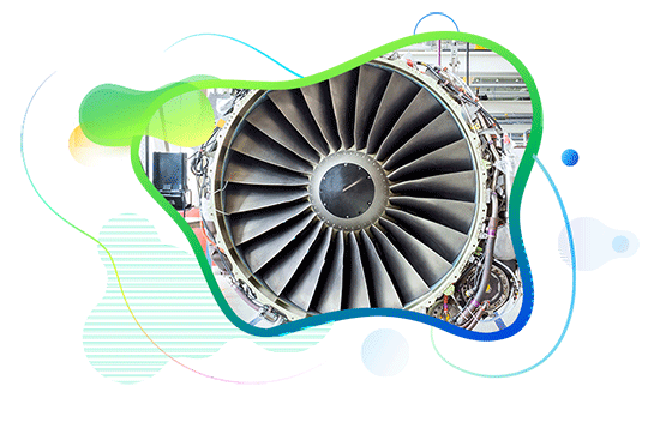
How Digitalizing Supply Chain Revolutionizes Aviation MRO
Published :

The aviation industry thrives on razor-sharp efficiency. Every minute an aircraft spends grounded translates to lost revenue, affecting the entire ecosystem. Maintenance, repair, and overhaul (MRO) operations are critical in keeping aircraft airworthy in this dynamic environment. However, paper-based workflows and siloed information within aviation MRO hinder efficient supply chain operations, impeding the industry’s ability to meet modern aviation demands. Digitalizing the supply chain through robust MRO aviation software could easily address the issues, enabling the service providers to up their game to ensure seamless experiences.
Before diving into the transformative power of digitalization, let's explore the complexities of managing the supply chain in the aviation MRO industry.
Manual processes and fragmented data make tracking inventory levels, part locations, and delivery schedules difficult in real-time. This lack of visibility can lead to delays in locating critical parts and ultimately extend aircraft downtime. Imagine a scenario where a mechanic needs a specific component to fix a grounded plane. In a traditional system, they might spend hours searching through physical records or contacting multiple suppliers, causing significant delays in the supply chain management. However, robust MRO software offering digitalized solutions can help avoid such a situation.
Guesswork often dictates stock levels in the supply chain in the absence of advanced MRO aviation software, leading to the risk of stock-outs or overstocking. Without a data-driven approach, MRO facilities struggle to ensure the right parts are available when needed. This leads to either production stoppages due to missing parts or wasted resources because of excessive stock.
Manual purchase orders, cumbersome communication with vendors and MRO software providers, and lengthy onboarding procedures can significantly slow down procurement within the supply chain and lead to missed deadlines. Inefficient procurement processes can have a ripple effect, delaying maintenance schedules and impacting flight operations.
The absence of a central platform creates communication gaps between airlines, MRO software providers, and manufacturers within the supply chain. This lack of information sharing hinders a unified approach to MRO activities. Airlines might not have real-time insights into parts availability at MRO facilities, leading to scheduling conflicts and delays.
As most MRO operators grapple with these challenges, they are likely missing out on the benefits that digitalization can usher in. For instance, an IATA report highlights airlines can achieve up to 15% reduction in maintenance costs through the adoption of advanced digital technologies, like MRO aviation software, in their MRO operations.
With OliverWyman predicting that the commercial aviation fleet will expand 33% by 2033, the US$125 billion MRO services (by 2033) must leverage existing technologies and emerging disruptors to address the growing demand.
According to a Roland Berger report, a core element of supply chain efficiency in the MRO sector is strengthening digital maturity. Digital maturity comprises a combination of predictive maintenance and continuous improvement, powered by technologies like IoT, AI, and blockchain. This digital transition of supply chain in aviation MRO can enhance operational efficiency, break down silos, improve transparency, and foster greater collaboration.
Predictive maintenance, employing data analytics and machine learning, forecasts equipment failures by leveraging IoT sensors for real-time component data. This proactive strategy significantly reduces downtime, optimizes maintenance schedules, and enhances operational efficiency. Using data analytics to identify bottlenecks, optimize processes, and measure progress ensures the digital transformation delivers tangible results.
Complementing this, continuous improvement is an ongoing process of refining operations through data-driven decisions, technological advancements, and collaborative efforts. By analyzing data and identifying process bottlenecks, MRO aviation software providers can implement targeted solutions to streamline workflows, decrease costs, and elevate customer satisfaction. Further, open communication and information sharing between all stakeholders fosters a more agile and responsive supply chain.
By embracing digitalization and integrating advanced technologies, MRO software providers can revolutionize their workflows, fostering collaboration and optimizing the supply chain in the MRO industry. According to a recent study by Aviation Week Network, 65% of MRO aviation software providers are prioritizing digital transformation initiatives to improve operational efficiency and reduce costs.
Several leading MRO software providers are already experiencing the transformative power of digitalization. For instance, this case study highlights how Ramco’s, a leading digital solutions provider for the MRO sector, innovation helped an airline major integrate MRO contracts, maintenance, and mobility contracts, resulting in a sharp 15% reduction in its production planning process.
The aviation MRO industry faces significant challenges due to paper-based processes and siloed information, impacting supply chain efficiency and aircraft availability. Digitalization is key to overcoming these hurdles. By implementing robust MRO software, industry players can improve supply chain visibility, optimize inventory, streamline procurement, and foster collaboration. Predictive maintenance and continuous improvement, powered by technologies like IoT, AI, and blockchain, are crucial for enhancing operational efficiency, reducing costs, and meeting the growing demands of the aviation sector.

All Rights Reserved. © Copyright 2024. Ramco Systems.